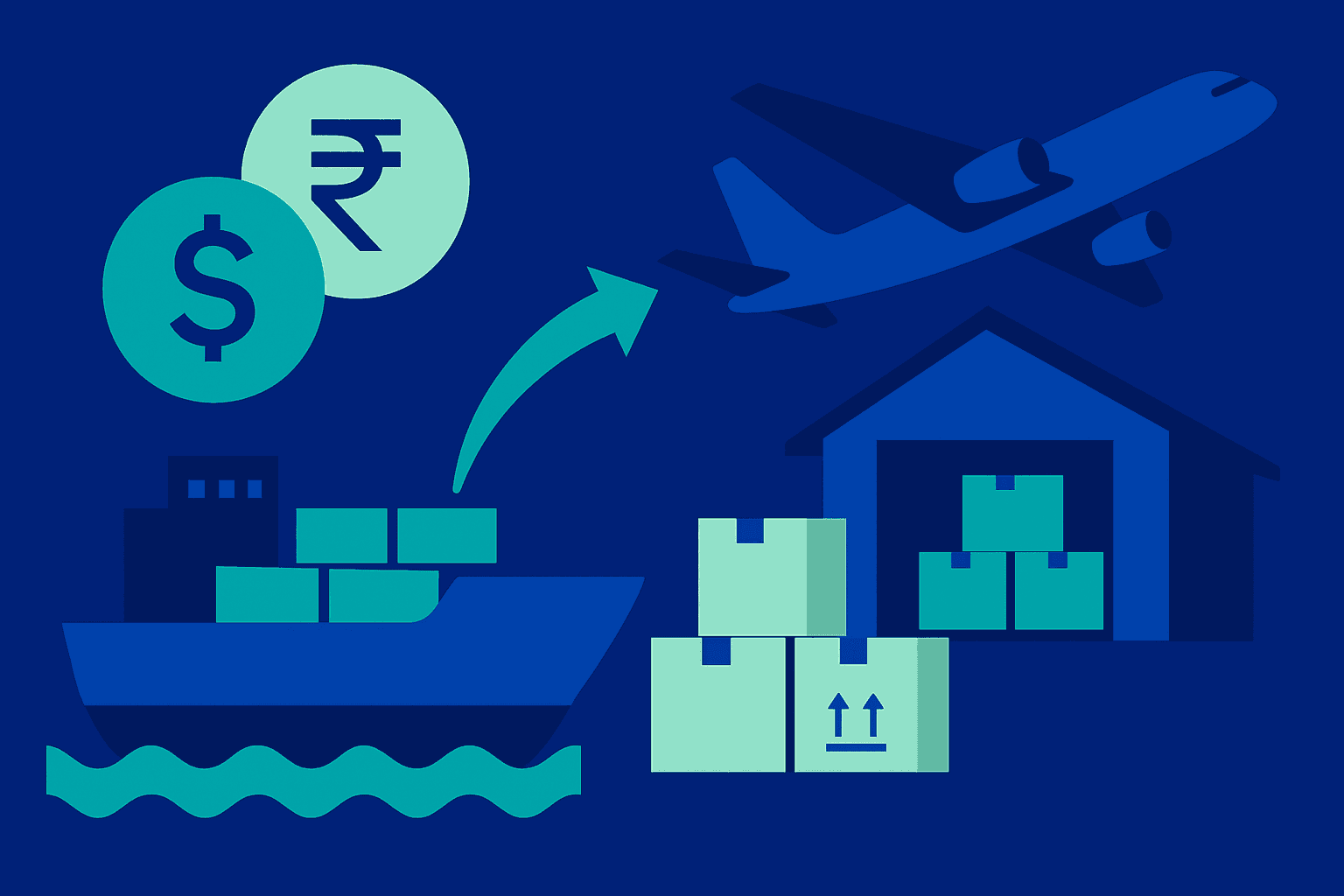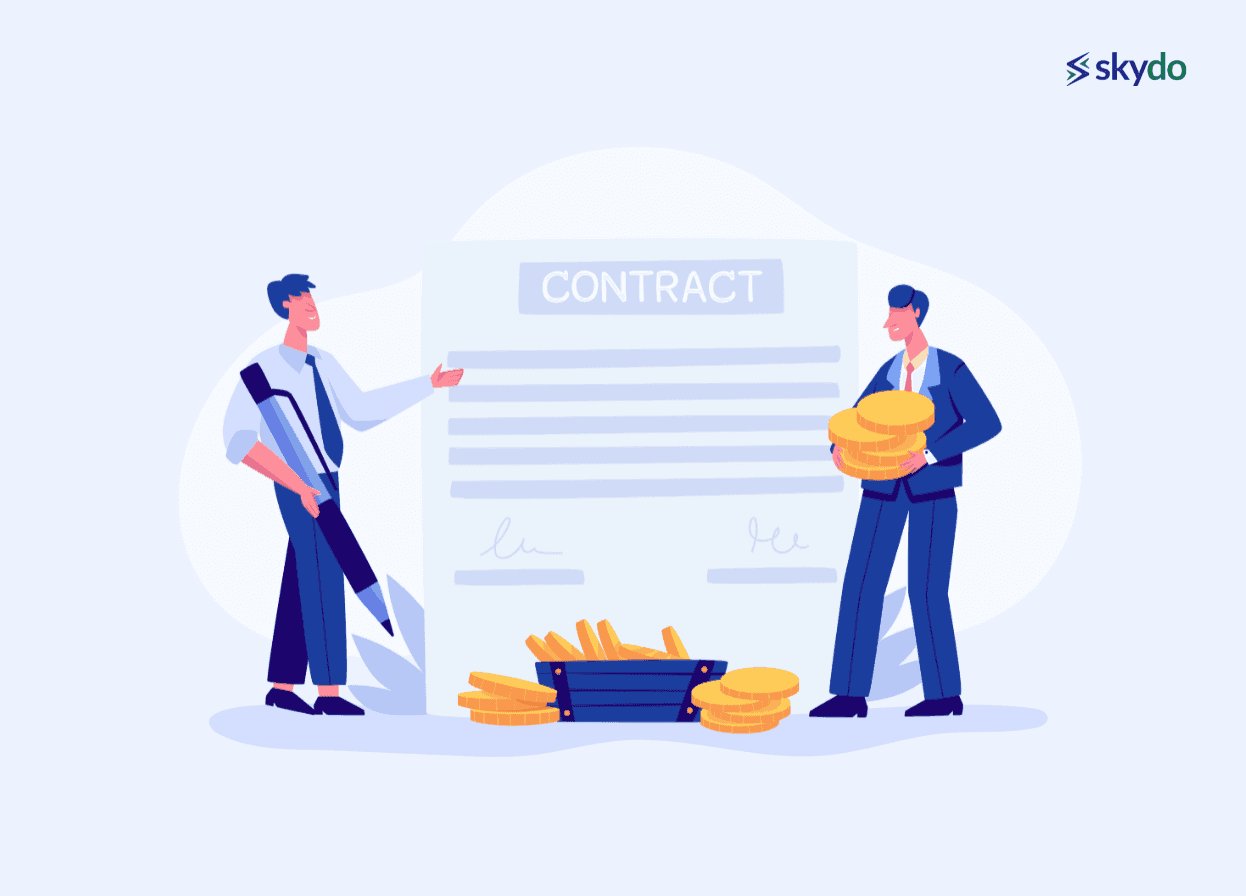Successful Strategies for Negotiating Freelancing Contracts
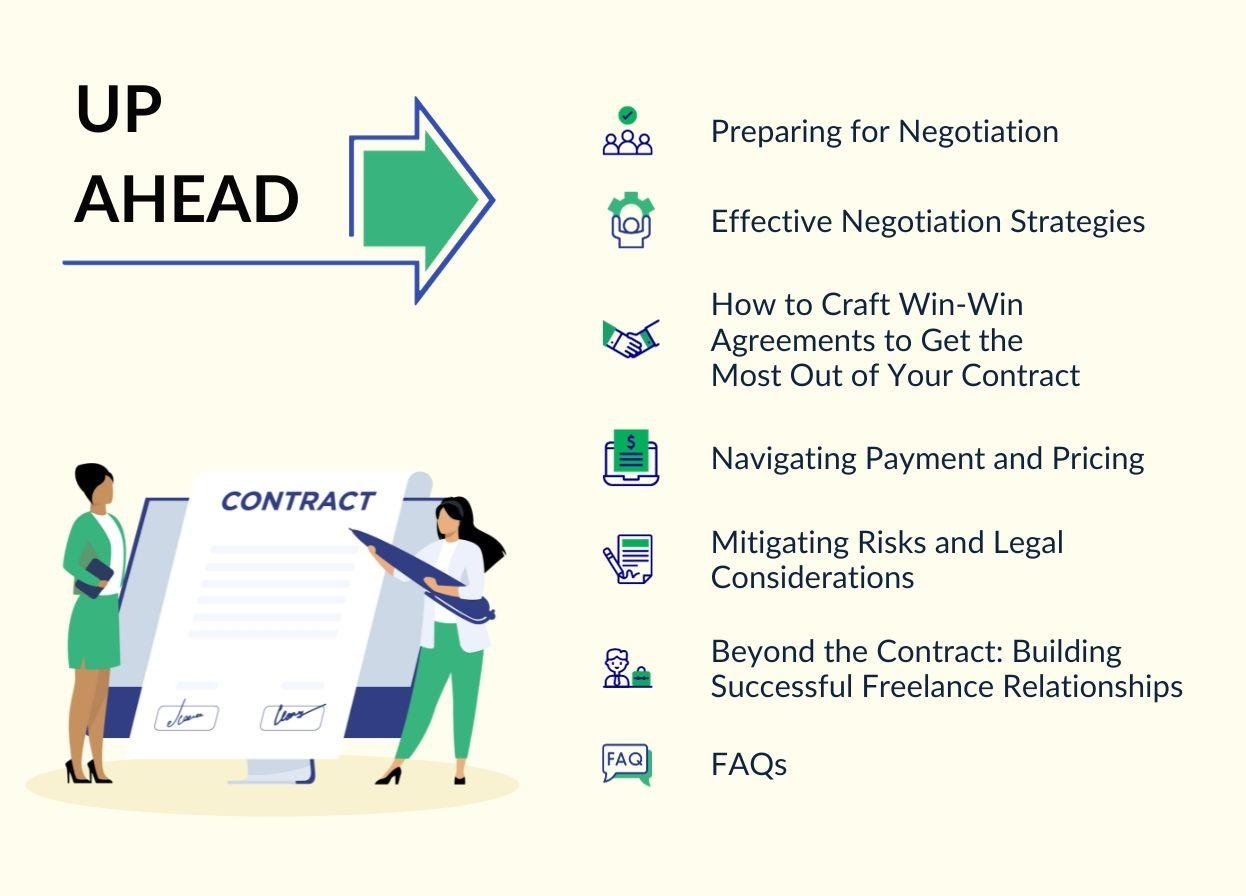

Working for yourself is fun, but it shouldn’t come at the cost of income stability!
In a recent survey conducted by McKinsey, around 36% of employed respondents identified as freelance, contract, or independent workers. According to Payoneer’s 2022 Global Freelancer Report, 32% of participants felt an increased demand for freelancers post-pandemic.
As the number of freelance opportunities increases worldwide, optimizing negotiating contracts to avoid being underpaid and ensuring personal career milestones are met is essential. All freelancers, whether writers, designers, or consultants, need to secure a contract that is fair, compatible, and in line with their aspirations.
But how do you prepare for it? What’s the right way to deal with conflict? How to ensure you fulfill all legal considerations?
This blog is a comprehensive guide outlining the key elements involved in successful contract negotiations, win-win agreements, and tips for negotiation strategies.
Preparing for Negotiation
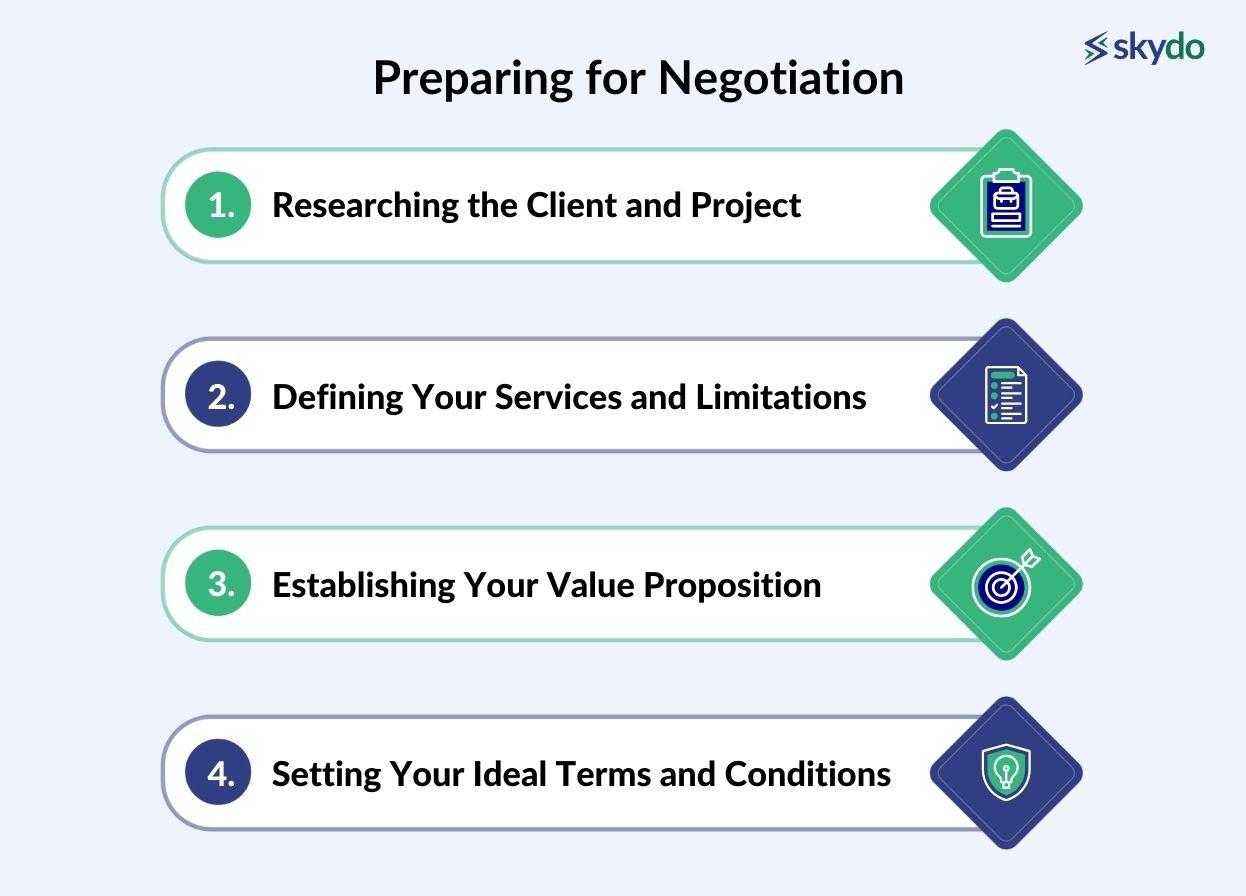
1. Researching the Client and Project
By understanding the client’s business, goals, and industry, you better know their pain points and objectives. This allows flexibility in tailoring proposals and setting project milestones specific to their needs when negotiating contracts.
2. Defining Your Services and Limitations
To minimize misunderstandings while working on a project, be transparent. Know yourself and clearly outline the services you provide/ don’t provide. Clarity in the early stages of freelancing contracts helps manage client expectations and avoids conflict.
3. Establishing Your Value Proposition
Highlight the unique skills and experiences that set you apart from others. The key is incentivizing the client to choose you to work with them. Emphasize how you can add value to their project and directly benefit their business. For e.g., highlight that you have skills to operate a special software/ tool that others don’t use.
4. Setting Your Ideal Terms and Conditions
Research standard industry rates and define your ideal contract terms. If you’re clueless, speak to people over LinkedIn or request your network to help you connect with the right folks.
Additionally, define deadlines and project scope with the client. Clarity about your boundaries and terms displays confidence, making negotiating contracts advantageous. For instance, if a client’s expectations about the completion of a project are unrealistic, be confident in responding with a realistic timeline that can work for both parties.
Effective Negotiation Strategies
Several negotiation strategies can be employed to set up your freelancing contracts.
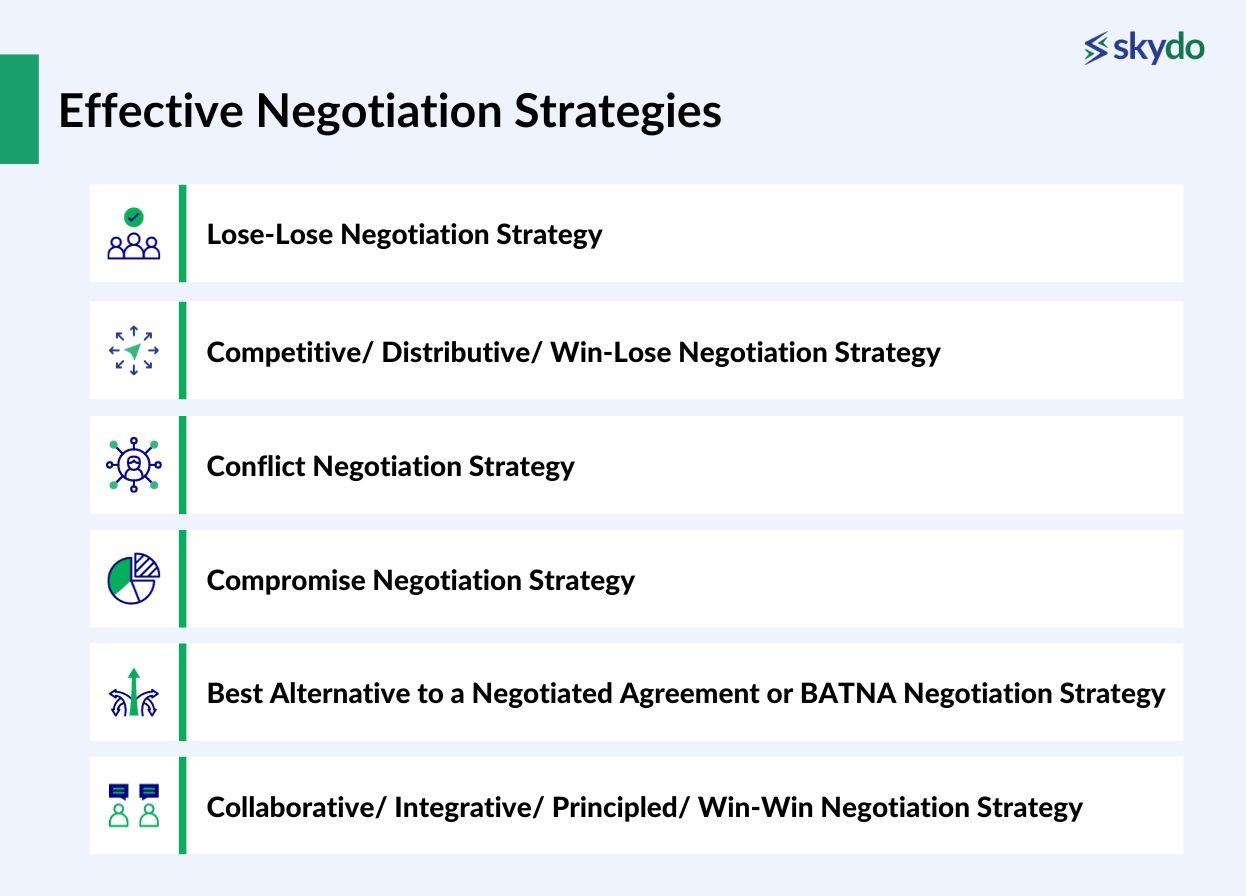
- Lose-Lose Negotiation Strategy
In this negotiation, there are no benefits to either party. Both parties end up with an unfavorable resolution. If you’ve decided not to work with them, employ this.
- Competitive/ Distributive/ Win-Lose Negotiation Strategy
This strategy involves maximizing your gains at the expense of the other party. In this situation, one party “wins” while the other sustains a “loss”. Unfortunately, you can’t build a longer relationship through this.
- Conflict Negotiation Strategy
Here, the two parties are at a standstill due to irreconcilable differences. In such a scenario, conflict resolution techniques are required to restart negotiations.
- Compromise Negotiation Strategy
Here, both parties reach a middle ground. However, neither party achieves their ideal outcome.
- Best Alternative to a Negotiated Agreement or BATNA Negotiation Strategy
This involves pre-determining your best alternative in case other negotiations fail as a fallback.
- Collaborative/ Integrative/ Principled/ Win-Win Negotiation Strategy
The best of all. Both parties jointly work together to maximize benefits when negotiating contracts. This type of negotiation strategy with increased collaboration leads to a win-win outcome that builds a good relationship between both parties.
The next section gives you some tips on how to craft a win-win agreement.
How to Craft Win-Win Agreements to Get the Most Out of Your Contract
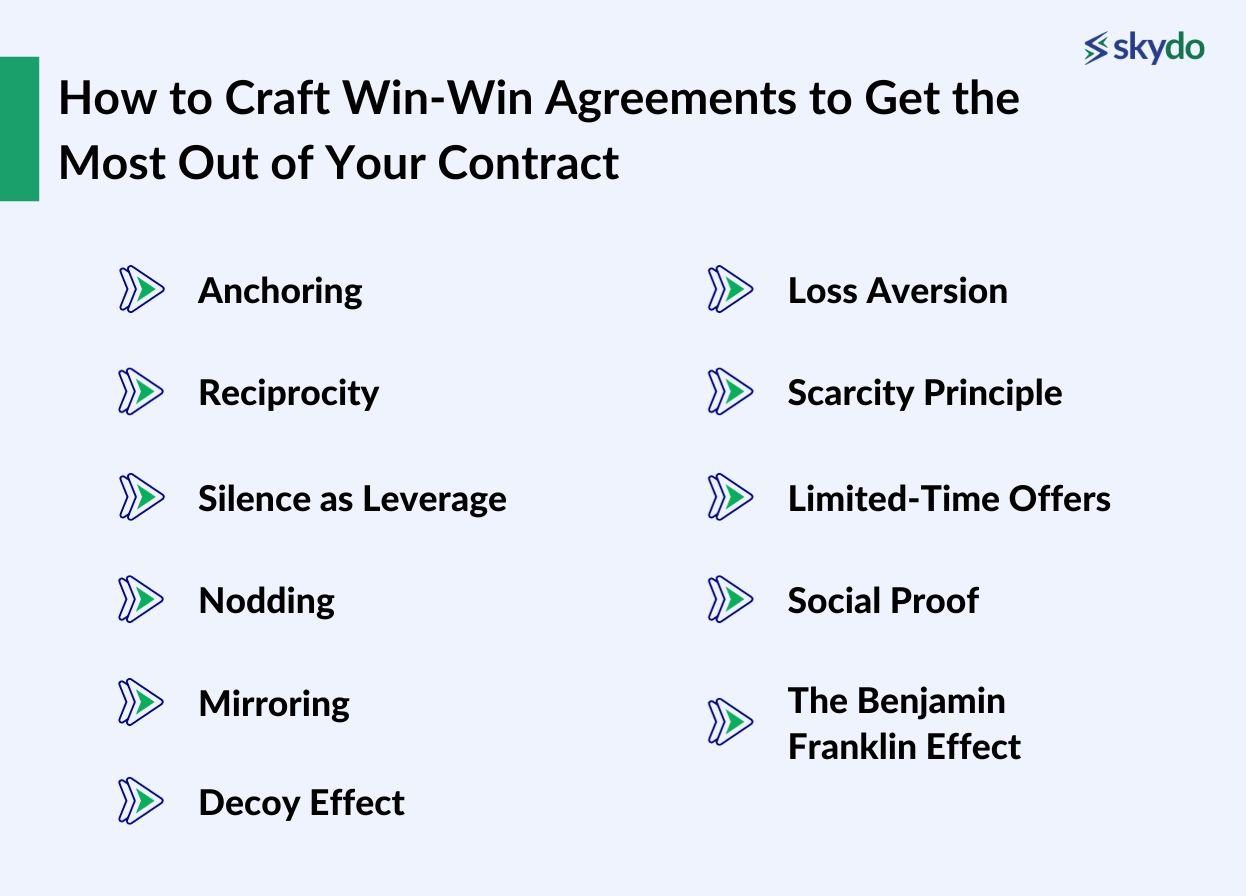
- Anchoring
Use the anchoring effect by starting with a strong, favorable point. This sets the tone for the negotiation and influences the perception of subsequent offers.
- Reciprocity
Offer concessions or information as a gesture of goodwill. The principle of reciprocity often encourages the other party to reciprocate, creating a more cooperative atmosphere.
- Silence as Leverage
Embrace strategic silence. After making an offer or stating your position, stay silent. The discomfort may prompt the other party to fill the silence with more favorable terms or concessions.
- Nodding
Use subtle nodding when discussing terms. Nodding signals agreement and can encourage the other party to agree with you or be more receptive to your proposals.
- Mirroring
Mimic the body language, tone, or speech patterns of the other party. Mirroring creates a subconscious connection and fosters a sense of rapport.
- Decoy Effect
Introduce a less attractive option (decoy) to make your preferred option more appealing. This cognitive bias can guide the other party toward the choice you want them to make.
- Loss Aversion
Highlight what the other party stands to lose by not reaching an agreement. People are often more motivated to avoid losses than to achieve equivalent gains.
- Scarcity Principle
Emphasize the scarcity or uniqueness of your offering. The fear of missing out (FOMO) can make the other party more willing to agree to your terms.
- The Benjamin Franklin Effect
Encourage the other party to do you a favor or seek their input. According to this effect, people tend to like you more after they've done something for you.
- Limited-Time Offers
Introduce a sense of urgency by creating deadlines or limited-time offers. The fear of missing out on a time-sensitive opportunity can drive quicker decision-making.
- Social Proof
Share success stories or testimonials to demonstrate that others have benefited from similar agreements. Social proof can build trust and credibility.
Navigating Payment and Pricing
1. Determining Fair and Competitive Pricing
Research standard industry rates for freelancers and competitors to determine fair and competitive pricing for your work. This ensures that you are not underpaid by the client. Additionally, there is nothing wrong with charging more than others, provided you can justify it.
2. Choosing Between Hourly, Project-Based, or Retainer Payment Models
Choose a payment model that suits you and aligns with the nature of the project, keeping client preference in mind. Choosing the right payment model can impact the stability of your income. If the client requires your service for a single project, choosing a project-based payment model is prudent. Consider an hourly payment model in case of a part-time opportunity.
3. Defining Payment Schedules and Methods
Be clear with the client regarding when and how payments will be made. This ensures you get compensated on time. This reduces financial uncertainties and maintains a relatively stable cash flow over the course of the project.
4. Incorporating Clauses for Late Payments or Revisions
Despite predetermined payment schedules, at times, payments may get delayed. Hence, it is better to include clauses addressing late payments and revisions to protect your interests. Employing negotiation strategies to include such clauses in your freelancing contract safeguards you in case of potential payment delays.
Mitigating Risks and Legal Considerations
These are the essential clauses of each contract. Please ensure that even simple contracts include them.
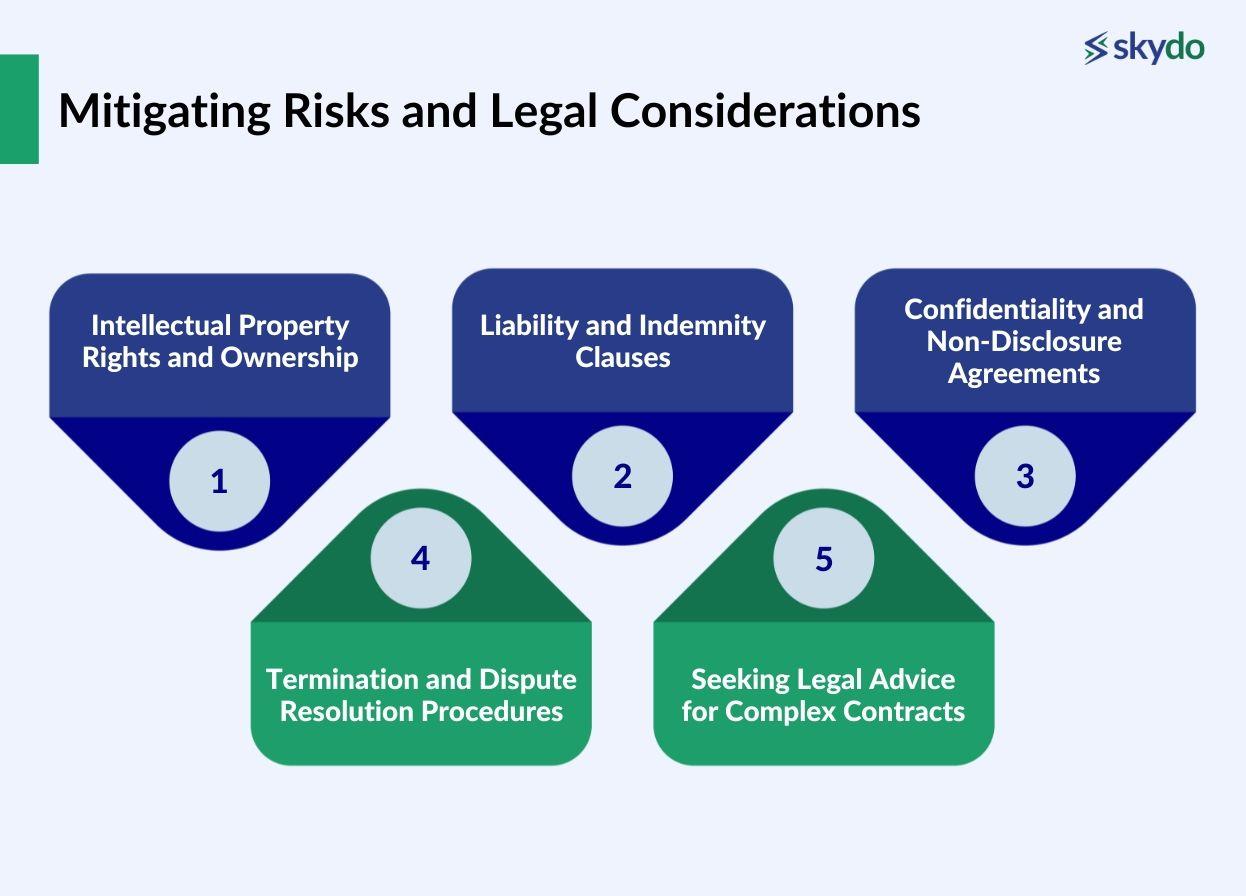
1. Intellectual Property Rights and Ownership
Clearly define and agree upon who owns the intellectual property created over the course of the project and under what conditions or formats it can be used when negotiating contracts. Establishing clear IP rights protects your work and prevents future disputes over ownership of the content created.
2. Liability and Indemnity Clauses
It is vital to protect yourself from potential legal repercussions. Incorporating liability and indemnity clauses while negotiating contracts can reduce legal risk. In the unfortunate scenario that a legal issue arises, this ensures clarity on with whom the responsibility lies.
3. Confidentiality and Non-Disclosure Agreements
Ensure you incorporate strict confidentiality and NDA clauses to safeguard sensitive client information. This builds trust and enhances rapport with the clients while safeguarding you from having your work reshared without your knowledge.
4. Termination and Dispute Resolution Procedures
Clearly outline the process for terminating your contract or resolving disputes in case such a situation arises with your client. This provides a structured and professional pathway in case of misunderstandings arising with either party involved. This can also prevent a lengthy legal process and ensure the dispute is resolved immediately.
5. Seeking Legal Advice for Complex Contracts
If the contract is long and complex, it is best to consult a legal team. This provides an additional layer of protection when negotiating your contract and ensures that all parties involved comply with the laws.
If you don’t have access to legal advice for your contracts, ensure that all the basics are covered. This includes project details, payment details, ownership rights, non-disclosure agreements, confidentiality agreements, termination agreements, exclusivity of services provided, and distribution rights of the work done.
Finalizing the Agreement
Before finalizing the contract, ensure you and the client fully understand and agree to cooperate with the contract terms. This establishes a strong foundation for the rest of the project timeline. Formalize the agreement without any doubts, clarification, or confusion.
Beyond the Contract: Building Successful Freelance Relationships
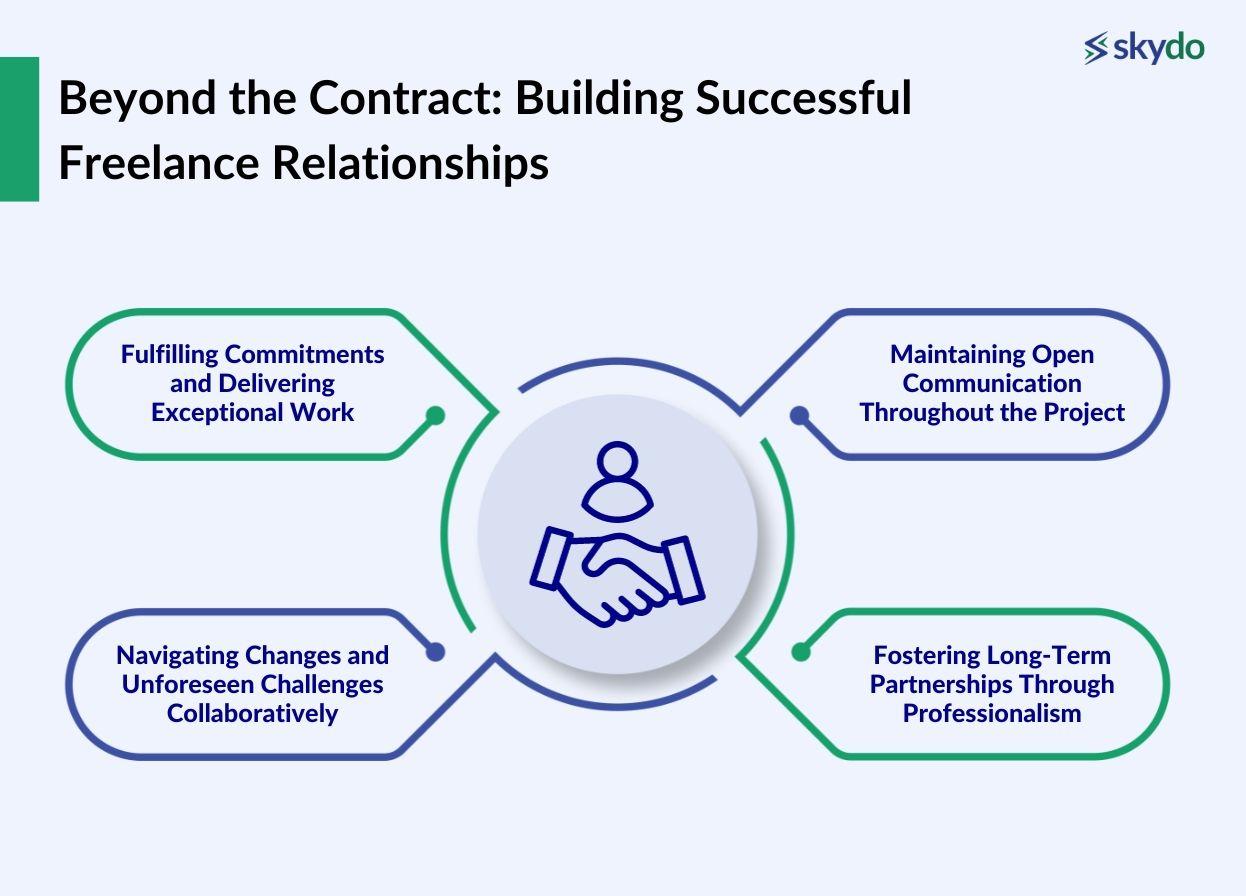
1. Fulfilling Commitments and Delivering Exceptional Work
Your reputation as a freelancer depends on your ability to fulfill the promises made in your contract. Stick to deadlines and deliver on quality. The foundation of any lasting client relationship is built on reliability and the consistent delivery of exceptional work that sets the stage for future collaborations.
2. Maintaining Open Communication Throughout the Project
According to Remote’s Global Freelancer Report of 2023, 60% of freelancers said managing client expectations was one of their biggest problems. Open communication with the client throughout the project makes it easier to resolve issues before they escalate or cause a delay in the completion of the project.
Establishing continuous contact with the client, maintaining transparency in communication, and ensuring client accessibility throughout the duration of the project enhances your relationship with the client as a freelancer. It is better to ensure regular updates and check-ins to show you are aligned with the client’s project vision.
3. Navigating Changes and Unforeseen Challenges Collaboratively
Throughout the timeline of a project, there may be unexpected hurdles. The priorities of a client’s vision could also shift. It is, thus, important to “go with the flow” in such a situation and embrace the change. Engage with the client in constructive conversations about necessary alterations in case of unforeseen challenges.
4. Fostering Long-Term Partnerships Through Professionalism
As a freelancer, it is important to behave with integrity and professionalism throughout the course of the project and show your dedication consistently. This creates a strong foundation and fosters long-lasting relationships with your client that could turn into multiple contracts as a freelancer.
Conclusion
Negotiating contracts is the foundation of the freelancing world. You will go a lot further by employing effective negotiation strategies and crafting win-win agreements while considering all the legal aspects.
Learning to negotiate a contract successfully is a useful skill that can significantly impact your future as a freelancer. Each negotiation could become a growth opportunity that builds more secure and lasting client relationships.
Frequently Asked Questions
Q1. How do I write a freelance contract agreement?
Ans: Writing a freelance contract involves outlining project details, deliverables, timelines, fees, payment terms, intellectual property rights, and dispute resolution. Use online templates or legal resources for a framework, then tailor it to fit your specific project and needs.
Q2. What is negotiating the terms of a contract?
Ans: Negotiating contract terms is discussing and reaching mutually agreeable conditions on aspects like payment structure, deadlines, project scope, revisions, and confidentiality. Be clear on your needs and value, research market rates, and prepare counter-offers if necessary.
Q3. What is the difference between a freelancer and a self-contractor?
Ans: Both are self-employed, but freelancers typically work on short-term projects for multiple clients, following client instructions. Self-contractors often handle specific tasks within a longer project for a single client, with more autonomy in execution. The type of work and client relationship are key distinctions.

